Yu Sheng - Uniquely Singaporean
 Saturday, February 19, 2011 at 8:00
Saturday, February 19, 2011 at 8:00 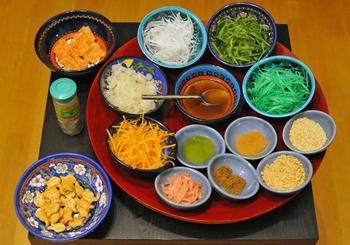 There are so many wonderful things about Singapore, most notably the food and the people.. I was blessed to spend quite a bit of time there while doing my MBA, and to have friends who really know what and where to eat (and who are willing to explain the significance of much of it)! In a society with heavy Cantonese influence, eating is one of the most important parts of life…a couple of my friends joke that you know you have some Cantonese blood when you’re in the middle of eating dinner and are planning what to eat for your meal. Then again, this can be said of some other cultures too….One of the first things I learned living in Thailand was that the question “gin khao lau ruu yang?” is literally translated as “have you eaten rice yet?” but really means “hi, how are you?”. Food – especially rice – is an integral part of the culture.
There are so many wonderful things about Singapore, most notably the food and the people.. I was blessed to spend quite a bit of time there while doing my MBA, and to have friends who really know what and where to eat (and who are willing to explain the significance of much of it)! In a society with heavy Cantonese influence, eating is one of the most important parts of life…a couple of my friends joke that you know you have some Cantonese blood when you’re in the middle of eating dinner and are planning what to eat for your meal. Then again, this can be said of some other cultures too….One of the first things I learned living in Thailand was that the question “gin khao lau ruu yang?” is literally translated as “have you eaten rice yet?” but really means “hi, how are you?”. Food – especially rice – is an integral part of the culture.
Though the general Chinese culture is the most dominant (including Malaysians, Indonesians, and others of Chinese heritage), you’ll also find traditions and food from Muslim, Hindu, Indian, Thai, Christian, and a variety of smaller, more specific groups. It’s a great place to have the chance to experience so many different festivals and celebrations – the decorations put up for Diwali and Christmas are absolutely gorgeous!
My favorite Singaporean tradition is also one of the ones that is uniquely Singaporean – tossing and eating Yu Sheng during Chinese New Year. Also called "Yu Sahng" (Cantonese), and the action of tossing it is “lo hei.”
(As a disclaimer, I’m no expert on this topic, just someone who really enjoyed it and wants to share with others….If you are an expert, feel free to comment and correct anything I missed!)
There’s some debate as to where the dish historically originated, but it definitely gained popularity in Singapore in the 1960’s thanks to the chefs at the Lai Wah restaurant. It’s usually served as the appetizer in one of those wonderful many-course Chinese feasts, as eating it is said to bring luck for the coming year. While you’ll find it throughout Singapore (take home packs are now conveniently available from many supermarkets) and parts of Malaysia, most in China have never heard of it. So, wherever it first began, it’s now a uniquely Singaporean tradition.
All of the ingredients have meanings behind them, some due to appearance, others related to the characters in the words. As the words for “abundance” and “fish” sound very similar (both “yu”), the dish called “raw fish” also is seen as symbolizing “abundance.” I’ll leave the more detailed linguistic analysis to someone who actually knows the language…
Every family and restaurant does it slightly differently in terms of ingredients and order. And though traditionally Yu Sheng is eaten on the 7th day of the New Year, these days many people will have it on any day during the 15 day holiday. It can get difficult to get reservations at a good restaurant on the most popular days!
I decided to give it try this year and make Yu Sheng for Herr J, and was pleasantly surprised that almost all ingredients were available (feel free to ask me where things are in Munich - I've spent a lot of time at the Asian stores).
Here we have all the ingredients laid out, ready to mix:
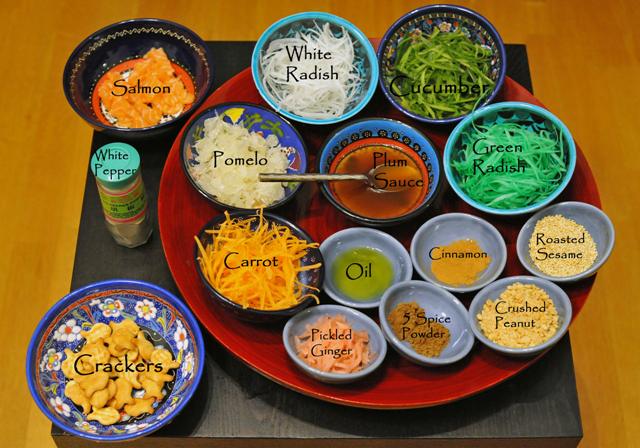
If you’re interested in the specific greeting to say for each ingredient, or some possible substitutions, Noob Cook has a great article on Yu Sheng, as does the National Library of Singapore. In fact, Noob Cook's article was indispensible in figuring out how to make this!
To begin, everyone exchanges wishes of good luck and other traditional New Years greetings. Then you assemble the ingredients (or in a restaurant this is done for you):
The ingredients (and their meanings) in our Yu Sheng were, in this order:
- Raw Salmon (symbolizing abundance and excess) (usually squeeze lime over it for extra luck)
- Pomelo (symbolizing an abundance of luck)
- White Pepper (sprinkled over the salmon and pomelo to attract more money and valuables)
- Olive Oil (poured in a circle around the ingredients to increase profits 10,000 times and bring in money from all directions)
- Carrots (bringing blessings of good luck)
- Green Radish1 (symbolizing eternal youth)
- White (Daikon) Radish (bringing prosperity in business and promotion at work)
- Crushed Roasted Peanuts (symbolizing your house being filled with gold and silver; also peanuts symbolize eternal youth)
- Roasted Sesame Seeds (symbolizing a flourishing business)
- Red Pickled Ginger (bringing blessings of good luck)
- Cucumber (I think similar to green radish)
- Cinnamon (bringing blessings of good luck)
- Chinese 5-Spice Powder (bringing 5 kinds of blessings)
- Crackers2 (they should resemble bags of gold, symbolizing your floor being covered with gold)
- Plum Sauce Dressing (plum sauce, mixed with sesame oil and hot water to thin it) (symbolizes your halls flowing with gold).
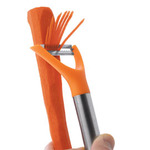 Julienne Veggie Peeler1The Green Radish is made by dyeing the White Radish with food coloring (same process for the green or red Yam).
Julienne Veggie Peeler1The Green Radish is made by dyeing the White Radish with food coloring (same process for the green or red Yam).
2 The correct kind of crackers are the Pok Chui crackers (fried flour crackers that sort of resemble bags of money), but forget about finding them here! You can substitute crackers made of fried wonton skins. I just thought the fish were cute and thought the shape symbolically fit well into the spirit of the dish.
3 The carrots, radish, and cucumber all should be shredded. The easiest way is to use a mandoline or a julienne peeler (see pic to the right). You should wrap each (separately) in paper towels until you’re ready to assemble, as this will soak up some moisture and keep your Yu Sheng crisp and fresh.
While it may vary slightly from family to family, there are certain greetings you say as you add each ingredient. But given my history of not getting the tones right in Thai, I was not going to risk pronouncing the Cantonese (or Mandarin) wrong and bringing bad luck upon us! Too often, saying something positive and something horribly offensive are just one wrong tone away from each other...
After greeting and assembling the ingredients, we get something like this:
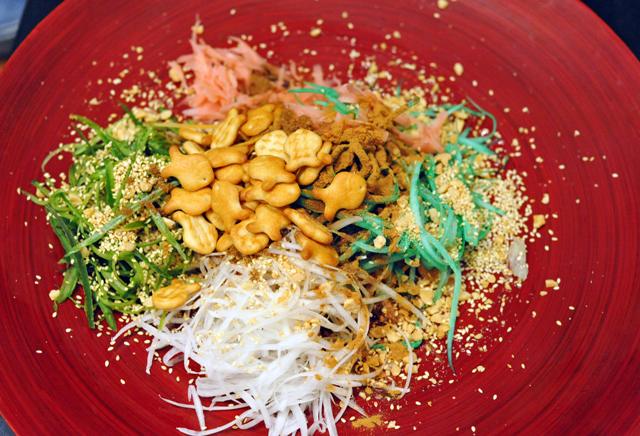
Then pour on the Plum Sauce mixture. Check out how cute these fish crackers are!
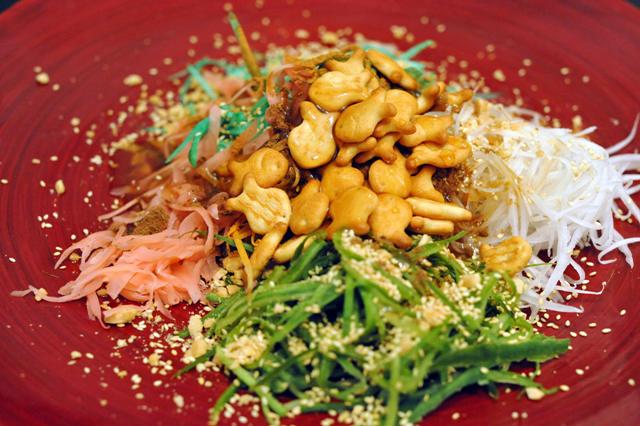
And then comes the fun part...everyone picks up their chopsticks and tosses the ingredients to mix them, saying "Lo hei!" or other blessings of good luck. Traditionally, the higher you toss, the better the luck, but laws of physics do play a part, as you'd like to keep some of it on the plate so you can eat it...
After a good tossing and improvising with some English words of good luck for the coming year, we ended up with this:
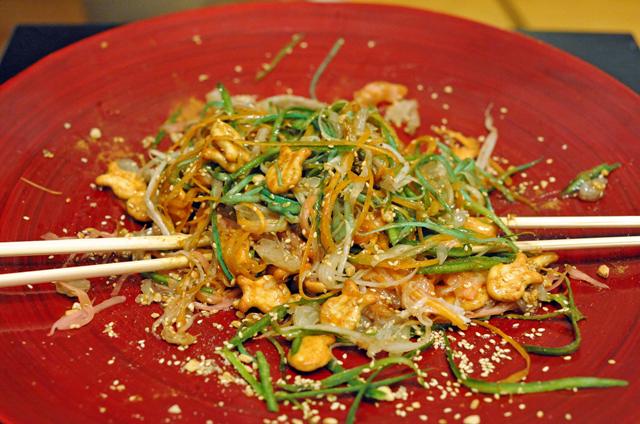 Yu Sheng, after tossing
Yu Sheng, after tossing
I was very happy it turned out so well...it was suprisingly tasty, too! I had expected it might not be so good, but that we'd eat a little to ensure good luck. We ate it all! I know they're an emergency substitution, but the fishie crackers really added something great. Not only are they cute, but they taste like buttery Ritz crackers! The fun of Goldfish, with the taste of Ritz. I won't lie: The jar did not last long in my house.
If you want see an actual tossing, one family put theirs on You Tube. They wisely covered the table in plastic....it can get messy, but that's half the fun! It's just a really nice tradition - it's usually very tasty, but it's a dish with meaning, and one that requires you to come together with family or friends around a table.
Thanks to my wonderful friends in Singapore for introducing me to such a great tradition, and to so many other things....
 Frau A ...
Frau A ...  3 Comments
3 Comments  Food, Cooking, & Dining,
Food, Cooking, & Dining,  Travel tagged
Travel tagged  New Year,
New Year,  Singapore,
Singapore,  Singaporean food,
Singaporean food,  pomelo
pomelo  1 Reference ...
1 Reference ...  Print Article
Print Article  Email Article
Email Article 



